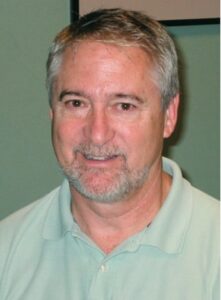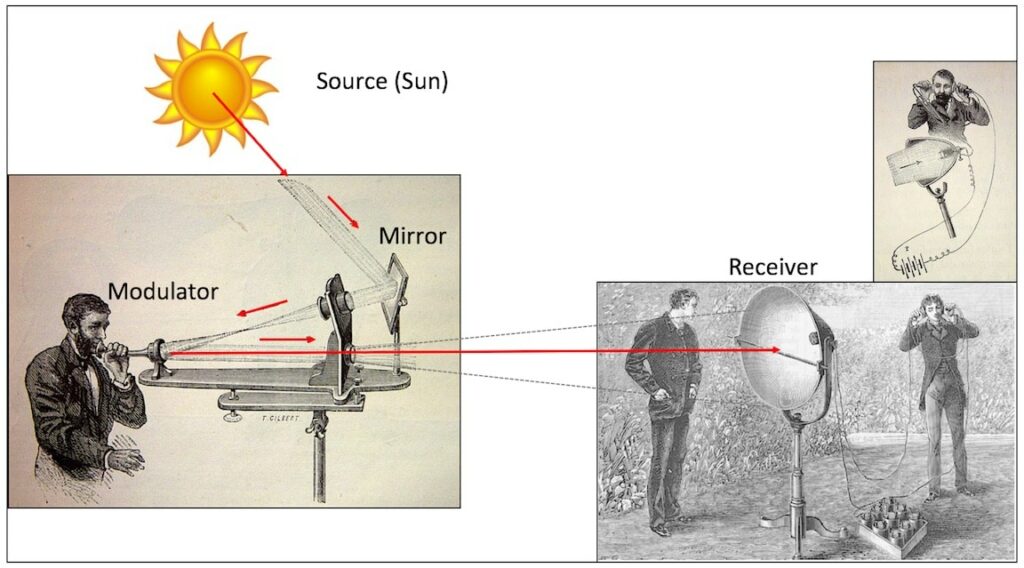A.G. Bell – An Analog Man Inventing Speech Riding on Light: Part 2

Christopher Schweizer, Ph.D.
Christopher Schweitzer, Ph.D.
In Part I of “Light ‘em up Mr. Bell: Li-Fi,” Alexander Graham Bell proposed speech riding on light as a means of communication. It was also wireless telecommunication, and in the 19th century! Bell believed his light-operated method of talking across distances (Figure 1) was a far more important invention than his original wired telephone.

Figure 1. Principle of Bell’s Photophone. Bell regarded his Photophone as: “the greatest invention I have ever made; greater than the telephone.” Alex and Charlie checking out their early version of a Li-Fi device.
Before Digital
Alexander Graham Bell’s genius had to proceed without the benefit of digital electronics, a condition practically unknown to most people under the age of 45. Even the antiquated squawks of dial up modems used the ones and zeroes of binary code, essentially products of information engineering from the laboratories that would come to honor his name (Bell Labs). Bell’s mode of message transmission was analog, which, like the recently re-popularized vinyl records, jiggled forth full re-constructions of the flowing patterns of articulated speech, rather than chunking it into numeric blocks as in digital hearing aids and CDs.
The Entire Signal Transmitted, Not Just Samples of Signals (as in digital)
Although working nearly 40 years after Samuel Morse had turned his attention from a successful career as an artist to long distance message conveyance with his invention of the Morse code, Bell’s modulation of electricity, and then light, were analog in nature. Voices were conveyed whole, not in numeric packets for re-assembly at the receiver – riding on a wave of sunlight in his photophone. He and Tainter’s method of bouncing sound via light from one location to another 200 meters away was in many regards an astonishingly early precursor of Wi-Fi but without the digital packets. Such packets are so fundamental to present day communications, that there are few tasks in hearing care, including entering a patient’s name and details, audiometric assessment on a digital audiometer, programming their digital amplification products, preparation of this short paper, and the posting of it on a web-based platform that do not use digitization. But regardless of the method of coding, professionals and consumers in the hearing products industry should take a great measure of pride in the remembrance that one of the luminaries involved in the inception and development of our inter-stitched world of telecommunications, from smart phones to satcom, was first of all an educator of the deaf.
What Next, Men and Women of Invention?
 Samuel Morse’s own first coded transmission on the opening of a Washington to Baltimore line was a bit of biblical scripture – “What hath God wrought?” It now seems appropriate to paraphrase the question for the inter-connected world to: ‘What next, men and women of invention? What next?’ Certainly, there is much yet to be illuminated about the neurophysiologic nature of message reception via acoustic connections, as well as the prospects for their restoration when damaged. But all indications are that progress will be much faster than the 100 plus years it took for the photophone to achieve notice again.
Samuel Morse’s own first coded transmission on the opening of a Washington to Baltimore line was a bit of biblical scripture – “What hath God wrought?” It now seems appropriate to paraphrase the question for the inter-connected world to: ‘What next, men and women of invention? What next?’ Certainly, there is much yet to be illuminated about the neurophysiologic nature of message reception via acoustic connections, as well as the prospects for their restoration when damaged. But all indications are that progress will be much faster than the 100 plus years it took for the photophone to achieve notice again.
Bell’s Failure Was Considered His Greatest Invention
To his passing in 1922, Bell believed that his photophone apparent failure was, in fact, his greatest invention. It turns out that the engineering field of ‘photonics’ is poised now to present significant transformations in the world of signals and systems.
Just as vast stretches of above-ground grids of power lines and roof top TV antennas have all but disappeared in suburbs and modern cities, future changes such as the previously mentioned constraints of bandwidth and advances in the ability to manipulate light for communications may call Bell’s idea back from the shadow of obscurity into common usage. Not inconceivably, the vision might one day include tiny LEDs transmitting to and from head worn devices from one individual to another within the distance and sight lines of normal conversations. That would presumably bring new meaning to the term ‘beamforming.’
References
Baljko, Jennifer. “A Bright Idea: Using light to transmit data” IHS Electronics360 15 March 2015.
https://purelifi.com/lifi-products/li-flame/
Jones, Nicola. “Light fantastic” New Scientist 3055 9 January 2016
NASA Engineers Are Transforming Communications with Light-Driven Modems IHS Electronics360 News Desk 03 February 2016.
Slovick, Murray. Move over Wi-Fi, here comes Li-Fi. HIS Electronics360, 11 March 2016.
———-
Christopher Schweitzer, Ph.D. lectures on Signals, Systems, and Speech at Salus University. He is Chief Technology Counselor for IMHear Corp and Director of Hear4U International.







Where can I find a head band which could say “I’m Hard of Hearing”. I could wear such to keep my Bi-Lateral implants in place as well as alert all health Care practitioners that I am HOH
Thanks,
Joe Nadeau
[email protected]
Nike makes a large array of Headbands which may suffice in this regard.